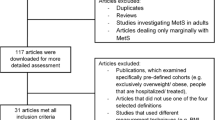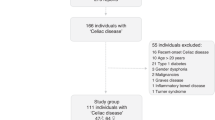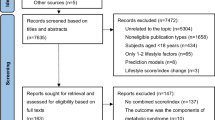Abstract
Background
There is no consensus regarding the definition of pediatric metabolic syndrome (MetS). This study assessed the impact of alternative definitions on the prevalence, children identified, and association with socioeconomic status (SES).
Methods
Data were from the prospective multigenerational Dutch Lifelines Cohort Study. At baseline, 9754 children participated, and 5085 (52.1%) with average follow-up of 3.0 (SD = 0.75) years were included in the longitudinal analyses; median ages were 12 (IQR = 10–14) and 14 years (IQR = 12–15), respectively. We computed MetS prevalence according to five published definitions and measured the observed proportion of positive agreement. We used logistic regression to assess the SES–MetS association, adjusted for age and sex. Longitudinal models were also adjusted for baseline MetS.
Results
MetS prevalence and positive agreement varied between definitions, from 0.7 to 3.0% and from 0.34 (95% CI: 0.28; 0.41) to 0.66 (95% CI: 0.58; 0.75) at baseline, respectively. We consistently found a socioeconomic gradient; in the longitudinal analyses, each additional year of parental education reduced the odds of having MetS by 8% (95% CI: 1%; 14%) to 19% (95% CI: 7%; 30%).
Conclusions
Alternative MetS definitions had differing prevalence estimates and agreed on 50% of the average number of cases. Additionally, regardless of the definition, low SES was a risk factor for MetS.
Impact
-
Little is known about the impact of using different definitions of pediatric metabolic syndrome on study results.
-
Our study showed that the choice of pediatric metabolic syndrome definition produces very different prevalence estimates.
-
We also showed that the choice of definition influences the socioeconomic gradient. However, low socioeconomic status was consistently a risk factor for having pediatric metabolic syndrome.
-
In conclusion, studies using different definitions of metabolic syndrome could be reasonably compared when investigating the association with socioeconomic status but not always validly when comparing prevalence studies.
Similar content being viewed by others
Log in or create a free account to read this content
Gain free access to this article, as well as selected content from this journal and more on nature.com
or
References
Ahrens, W. et al. Metabolic syndrome in young children: definitions and results of the IDEFICS study. Int. J. Obes. 38(Suppl 2), S4–S14 (2014).
Schubert, C. M., Sun, S. S., Burns, T. L., Morrison, J. A. & Huang, T. T. Predictive ability of childhood metabolic components for adult metabolic syndrome and type 2 diabetes. J. Pediatr. 155, S6 e1–S6 e7 (2009).
Huang, T. T., Nansel, T. R., Belsheim, A. R. & Morrison, J. A. Sensitivity, specificity, and predictive values of pediatric metabolic syndrome components in relation to adult metabolic syndrome: the Princeton LRC follow-up study. J. Pediatr. 152, 185–190 (2008).
Magnussen, C. G. et al. Continuous and dichotomous metabolic syndrome definitions in youth predict adult type 2 diabetes and carotid artery intima media thickness: the Cardiovascular Risk in Young Finns Study. J. Pediatr. 171, 97–103 (2016).
Puolakka, E. et al. Childhood socioeconomic status in predicting metabolic syndrome and glucose abnormalities in adulthood: the Cardiovascular Risk in Young Finns Study. Diabetes Care 39, 2311–2317 (2016).
Magnussen, C. G. et al. Pediatric metabolic syndrome predicts adulthood metabolic syndrome, subclinical atherosclerosis, and type 2 diabetes mellitus but is no better than body mass index alone: the Bogalusa Heart Study and the Cardiovascular Risk in Young Finns Study. Circulation 122, 1604–1611 (2010).
IHME. GBD Compare Data Visualization (University of Washington, Seattle, WA, 2020).
Magge, S. N. et al. The metabolic syndrome in children and adolescents: shifting the focus to cardiometabolic risk factor clustering. Pediatrics 140, e20171603 (2017).
Friend, A., Craig, L. & Turner, S. The prevalence of metabolic syndrome in children: a systematic review of the literature. Metab. Syndr. Relat. Disord. 11, 71–80 (2013).
Henderson, M., Van Hulst, A., von Oettingen, J. E., Benedetti, A. & Paradis, G. Normal weight metabolically unhealthy phenotype in youth: do definitions matter? Pediatr. Diabetes 20, 143–151 (2019).
Braveman, P. & Gottlieb, L. The social determinants of health: it’s time to consider the causes of the causes. Public Health Rep. 129(Suppl 2), 19–31 (2014).
Marmot, M. & Bell, R. Fair society, healthy lives. Public Health 126 Suppl 1, S4–S10 (2012).
Gebremariam, M. K., Lien, N., Nianogo, R. A. & Arah, O. A. Mediators of socioeconomic differences in adiposity among youth: a systematic review. Obes. Rev. 18, 880–898 (2017).
Maty, S. C., Lynch, J. W., Raghunathan, T. E. & Kaplan, G. A. Childhood socioeconomic position, gender, adult body mass index, and incidence of type 2 diabetes mellitus over 34 years in the Alameda County Study. Am. J. Public Health 98, 1486–1494 (2008).
Pollitt, R. A., Rose, K. M. & Kaufman, J. S. Evaluating the evidence for models of life course socioeconomic factors and cardiovascular outcomes: a systematic review. BMC Public Health 5, 7 (2005).
Iguacel, I. et al. Prospective associations between socioeconomically disadvantaged groups and metabolic syndrome risk in European children. Results from the IDEFICS study. Int. J. Cardiol. 272, 333–340 (2018).
MacPherson, M., de Groh, M., Loukine, L., Prud’homme, D. & Dubois, L. Prevalence of metabolic syndrome and its risk factors in Canadian children and adolescents: Canadian Health Measures Survey Cycle 1 (2007-2009) and Cycle 2 (2009-2011). Health Promot. Chronic Dis. Prev. Can. 36, 32–40 (2016).
Scholtens, S. et al. Cohort profile: LifeLines, a three-generation cohort study and biobank. Int. J. Epidemiol. 44, 1172–1180 (2015).
Stolk, R. P. et al. Universal risk factors for multifactorial diseases: LifeLines: a three-generation population-based study. Eur. J. Epidemiol. 23, 67–74 (2008).
Cook, S., Weitzman, M., Auinger, P., Nguyen, M. & Dietz, W. H. Prevalence of a metabolic syndrome phenotype in adolescents: findings from the third National Health and Nutrition Examination Survey, 1988-1994. Arch. Pediatr. Adolesc. Med. 157, 821–827 (2003).
de Ferranti, S. D. et al. Prevalence of the metabolic syndrome in American adolescents: findings from the Third National Health and Nutrition Examination Survey. Circulation 110, 2494–2497 (2004).
Zimmet, P. et al. The metabolic syndrome in children and adolescents - an IDF consensus report. Pediatr. Diabetes 8, 299–306 (2007).
Eisenmann, J. C., Laurson, K. R., DuBose, K. D., Smith, B. K. & Donnelly, J. E. Construct validity of a continuous metabolic syndrome score in children. Diabetol. Metab. Syndr. 2, 8 (2010).
Mellerio, H. et al. Novel modeling of reference values of cardiovascular risk factors in children aged 7 to 20 years. Pediatrics 129, e1020–e1029 (2012).
De Graaf, N. D., De Graaf, P. M. & Kraaykamp, G. Parental cultural capital and educational attainment in the Netherlands: a refinement of the cultural capital perspective. Sociol. Educ. 73, 92–111 (2000).
Winkleby, M. A., Jatulis, D. E., Frank, E. & Fortmann, S. P. Socioeconomic status and health: how education, income, and occupation contribute to risk factors for cardiovascular disease. Am. J. Public Health 82, 816–820 (1992).
Treiman, D. J. Occupational Prestige in Comparative Perspective (Academic Press, 1977).
Cicchetti, D. V. & Feinstein, A. R. High agreement but low kappa: II. Resolving the paradoxes. J. Clin. Epidemiol. 43, 551–558 (1990).
Kirkwood, B. R. & Sterne, J. A. C. In Essential Medical Statistics Ch. 36 (Blackwell Science, Malden, MA, 2003).
van Buuren, S. & Groothuis-Oudshoorn, K. mice: Multivariate imputation by chained equations in R. J. Stat. Softw. 45, 67 (2011).
R Core Team. R: A Language and Environment for Statistical Computing (R Foundation for Statistical Computing, Vienna, 2018).
Byrt, T., Bishop, J. & Carlin, J. B. Bias, prevalence and kappa. J. Clin. Epidemiol. 46, 423–429 (1993).
Grundy, S. M. et al. 2018 AHA/ACC/AACVPR/AAPA/ABC/ACPM/ADA/AGS/APhA/ASPC/NLA/PCNA Guideline on the Management of Blood Cholesterol: A Report of the American College of Cardiology/American Heart Association Task Force on Clinical Practice Guidelines. Circulation 139, e1082–e1143 (2019).
Flynn, J. T. et al. Clinical practice guideline for screening and management of high blood pressure in children and adolescents. Pediatrics 140, e20171904 (2017).
Expert Panel on Integrated Guidelines for Cardiovascular Health and Risk Reduction in Children and Adolescents. Expert panel on integrated guidelines for cardiovascular health and risk reduction in children and adolescents: summary report. Pediatrics 128(Suppl 5), S213–S256 (2011).
DeBoer, M. D. Assessing and managing the metabolic syndrome in children and adolescents. Nutrients 11, 1788 (2019).
Klijs, B. et al. Representativeness of the LifeLines Cohort Study. PLoS ONE 10, e0137203 (2015).
WHO. Healthy, Prosperous Lives for All: The European Health Equity Status Report (WHO Regional Office for Europe, Copenhagen, 2019).
Acknowledgements
The authors are grateful to Josué Almansa, PhD (Department of Health Sciences, University Medical Center Groningen, University of Groningen) who provided valuable methodological guidance when discussing how to impute data and measure agreement. This study is part of the TRANSSES project which is funded by ZonMw (Grant 531003011).
Author information
Authors and Affiliations
Contributions
A.L. conceptualized and designed this study, carried out the analyses, drafted the initial manuscript, and reviewed and revised the manuscript. M.L.A.d.K. and S.A.R. conceptualized, designed, and supervised this study; reviewed and revised the manuscript; conceived the project; and obtained the grant for the project TRANSSES. A.F.d.W. conceptualized, designed, and supervised this study and reviewed and revised the manuscript. All authors read and approved the final manuscript as submitted and agree to be accountable for all aspects of the work.
Corresponding author
Ethics declarations
Competing interests
The authors declare no competing interests.
Consent statement
This study uses data from the Lifelines Cohort study, which obtained written informed consent for each participant prior to participating in the cohort.
Additional information
Publisher’s note Springer Nature remains neutral with regard to jurisdictional claims in published maps and institutional affiliations.
Rights and permissions
About this article
Cite this article
Lepe, A., de Kroon, M.L.A., de Winter, A.F. et al. Alternative pediatric metabolic syndrome definitions impact prevalence estimates and socioeconomic gradients. Pediatr Res 90, 694–700 (2021). https://doi.org/10.1038/s41390-020-01331-3
Received:
Revised:
Accepted:
Published:
Issue date:
DOI: https://doi.org/10.1038/s41390-020-01331-3
This article is cited by
-
Educational inequalities in metabolic syndrome prevalence, timing, and duration amongst adults over the life course: a microsimulation analysis based on the lifelines cohort study
International Journal of Behavioral Nutrition and Physical Activity (2023)
-
Comparison of the ability of HOMA-IR, VAI, and TyG indexes to predict metabolic syndrome in children with obesity: a cross-sectional study
BMC Pediatrics (2023)



